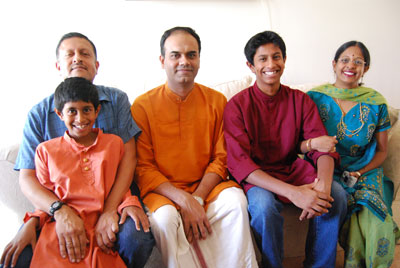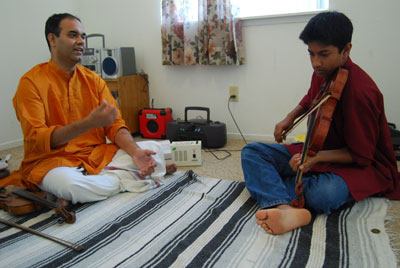 Editor’s Note: Master artist Parasuraman SunderRajan (Lake Forest) and apprentice Kiran Athreya (Lake Forest) are current participants in the Alliance’s Apprenticeship Program, conducting an apprenticeship in South Indian Carnatic violin. In the following article, 16-year old apprentice Kiran Athreya discusses his experience as an apprentice to Mr. SunderRajan and as a participant in the Apprenticeship Program.
Editor’s Note: Master artist Parasuraman SunderRajan (Lake Forest) and apprentice Kiran Athreya (Lake Forest) are current participants in the Alliance’s Apprenticeship Program, conducting an apprenticeship in South Indian Carnatic violin. In the following article, 16-year old apprentice Kiran Athreya discusses his experience as an apprentice to Mr. SunderRajan and as a participant in the Apprenticeship Program.
Carnatic music is a system of music commonly associated with the southern part of India, formerly known as Bharath. This system mainly originated from the four main states of India: Andhra Pradesh, Karnataka, Kerala, and Tamil Nadu. In contrast to Hindustani music from northern part of India, the main emphasis of Carnatic music is on vocals. Over the years, many instruments were added to form an ensemble. For example, the tabla (drums) that was brought from North India is now being used in South Indian devotional music. Just like the tabla, the violin was acquired from the Western world. As used in symphonic bands and orchestras, the violin now plays a vital role in a South Indian classical concert.
I was born in a family that supported and nourished music. In addition to being professional engineers, my parents were well versed in vocal music from very young age, inspiring us to continue the tradition. My older sister chose dance, and is currently a very accomplished Baratha Natyam dancer, while I received training playing the violin, and my younger brother in vocal music. Although the violin is one of the most difficult string instruments in Indian music, I decided to take on the challenge and pursue the art.
I started my violin training when I was nine years old from a very accomplished violin maestro Mr. Delhi Parasuraman SunderRajan on August 3, 2001. The training commenced with an offering of fruits and a gift to the Guru (the teacher). At first, I was very anxious because I didn’t know Mr. SunderRajan’s personality. After few sessions, Mr. SunderRajan made me very comfortable and I was pleasantly surprised to see that he was modest and a very friendly person even with all his accomplishments in the field of music. Since then, our friendship has grown tremendously. This friendship has helped to make my classes fun and enjoyable, rather than stressful and overwhelming.
As I started my violin classes, Mr. SunderRajan taught me the basic finger placements and techniques just as in any other art. There were many rules and regulations related to the art such as sitting posture, bowing techniques, and instrument handling. After several weeks of basic training, Mr. Sunderrajan taught me the different scales which are the building blocks for various melodies. The melodies are referred to as ragas and each song is set in a raga. After years of training and learning various songs and scales, Mr. SunderRajan went to the next levels and taught the art of raga alapanas. Alapana is the expansion of a tune using the notes in the scale in different melodic patterns. The art of playing raga alapanas is very challenging and requires experience in the ragas. It can really test the knowledge of the player in that particular tune. As there are thousands of ragas, a simple slip of the finger can be disastrous. The player has to be very cautious to stay within the scale and still demonstrate their knowledge. With time and practice, playing ragas got easier. It also helped me to immerse myself in the mellifluent tunes and feel the beauty of the music. In a typical South Indian vocal concert, unlike a solo violin concert, the accompanying violinist assumes a supporting role. In this, the violinist is required to follow along and will be given an opportunity to expand the raga in a solo style immediately after the vocalist’s rendition of the raga. Although accompanying doesn’t seem like the main role, the success of the concert depends on the knowledge of the violinist and the art of accompanying. It is not an easy task especially when the violinist has no prior knowledge of the ragas or the songs that are chosen for the concert by the vocalist. These skills are learned over 5-6 years of training, attending concerts, and accompanying vocalists.
 In the last few years, many Carnatic music and Bharatha Natyam teachers in Southern California have supported me by including me in their music ensemble for recitals and performances as an accompanying artist. This was a challenge at first and helped me tremendously to improve the knowledge of raga and build confidence in my musical expertise. It also helped me with the stage presence in front of a large audience. It was not an easy task to perform especially in front of many experts in the audience. I progressed well over the years and with encouragement and long hours of practice with my guru Mr. SunderRajan. In light of the advances I made, Mr. SunderRajan suggested that I was ready and could apply for the Alliance’s Apprenticeship Program. Although flattered by his confidence in my abilities, I was excited at the thought of being one among the few recipients of the apprenticeship. However, I was terrified at the prospect of a solo public sharing concert at the end of the scholarship period. Mr. Sunderrajan and I spent a lot of time together to finally accomplish the goal. By October 2008, I was fairly confident with all the ragas and the songs that were chosen for the concert. Along with raga expansion, one of the main purposes of the apprenticeship was to learn yet another new concept, the swaras. Swaras is a concept where the musician rearranges the notes in the scale to certain set of beats. These patterns of musical notes are created extempore by the musician that demonstrates the knowledge of the scale. There are myriad patterns that are set in a pyramid like arrangement starting with eight beats to sixty-four or higher and gradually back to eight, ending on a particular note.
In the last few years, many Carnatic music and Bharatha Natyam teachers in Southern California have supported me by including me in their music ensemble for recitals and performances as an accompanying artist. This was a challenge at first and helped me tremendously to improve the knowledge of raga and build confidence in my musical expertise. It also helped me with the stage presence in front of a large audience. It was not an easy task to perform especially in front of many experts in the audience. I progressed well over the years and with encouragement and long hours of practice with my guru Mr. SunderRajan. In light of the advances I made, Mr. SunderRajan suggested that I was ready and could apply for the Alliance’s Apprenticeship Program. Although flattered by his confidence in my abilities, I was excited at the thought of being one among the few recipients of the apprenticeship. However, I was terrified at the prospect of a solo public sharing concert at the end of the scholarship period. Mr. Sunderrajan and I spent a lot of time together to finally accomplish the goal. By October 2008, I was fairly confident with all the ragas and the songs that were chosen for the concert. Along with raga expansion, one of the main purposes of the apprenticeship was to learn yet another new concept, the swaras. Swaras is a concept where the musician rearranges the notes in the scale to certain set of beats. These patterns of musical notes are created extempore by the musician that demonstrates the knowledge of the scale. There are myriad patterns that are set in a pyramid like arrangement starting with eight beats to sixty-four or higher and gradually back to eight, ending on a particular note.
Another concept Mr. Sunderrajan taught me during the apprenticeship was playing a ragamalika. Ragamalikas are songs that have many different scales put together into one song. The transition between the scales becomes difficult even for an experienced musician as there is no gap between transitions. Mr. Sunderrajan taught me the scales and made me master them to a point where I could transition from one scale to the next while making it sonorous to the listener.
Even with all the preparation, the day of the concert I was extremely nervous, because many people in the crowd were very well versed in South Indian classical music so there was no margin for error. Throughout the introduction I was practically shaking because it was my first solo concert and I knew that it had to be flawless. With my master’s expert teaching and many hours of hard work, I was able to give my first solo recital that met the expectations of the audience and made my teacher proud.
In conclusion, my participation in Alliance’s Apprenticeship Program provided me with the focus and resources to advance in the field of music. I value this experience that has brought out the best in me. I thank the Alliance for awarding me and Mr. SunderRajan the apprenticeship.
